by Winding Pathways | Sep 22, 2022 | (Sub)Urban Homesteading, Amphibians/Reptiles, Birds, Garden/Yard, Nature
We hadn’t seen either for a while but one September morning there they were. Mr. Toad and Ms. Wren.
Mr. Toad
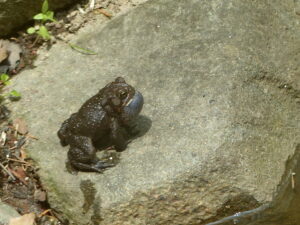
Toads sing loudly day and night.
All summer Mr. Toad contentedly lived beneath a tomato plant snacking on an occasional juicy bug. Ms. Wren meanwhile forayed about the yard snatching bugs and feeding her brood. In September Mr. Toad’s favorite tomato plant died back, probably tired after producing plenty of tasty fruits and no longer able to give Mr. Toad a worthy hiding place. And, after the babies fledged, Ms. Wren worked the prairie grasses and woods.
On that September morning, Rich noticed sweet potato leaves trembling a bit. He brushed aside the foliage and there was Mr. Toad out seeking breakfast.
The fall equinox is almost here. With it comes the short days and cool temperatures that make garden plants shrink. Mr. Toad is cold-blooded. Summer’s moist heat is to his liking, but before the cold comes, he must retire for the winter. So, down he goes, digging into the soil to find a place to snooze through the winter, no doubt dreaming about next summer’s juicy bugs under a new tomato plant.
We bid Mr. Toad adieu for the winter and said, “Thanks for helping with our gardening. See you next spring.”
Ms. Wren
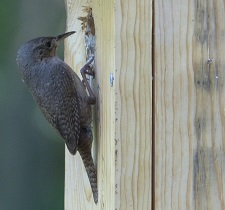
Checking the nest box.
Mr. Toad isn’t our only garden worker. Last winter we set up a wren house and by May Ms. Wren and her partner moved in. The couple raised two broods of ravenous babies in our garden. They enjoy the same fare as Mr. Toad but hunt more in our crop’s leaves instead of under them. The industrious parents spend nearly every daylight hour combing the garden and beyond for insects to feed their chicks.
Our last brood of garden wrens fledged in mid-August but stuck around a while. The family hunts insects in the woods behind the house but by the fall equinox they’ll get the urge to hop on a north wind some night and head south. When we’re shoveling snow, they’ll be snacking on bugs in a warm place.
Parting is Sweet Sorrow When Mr. Toad and Ms. Wren Bid Us Adieu
It’s hard to tell exactly when our wrens leave. Sometimes they linger into October but eventually one of us will say, “I haven’t seen or heard a wren for a while.” Yup, they’ve left for the season. We also bid them adieu and say, “Come back. See you next spring.” We miss Mr. Toad and Ms. Wren for the good work they do and for knowing we provide safe homes for them. We will put up wren boxes come March of next year and search for Mr. Toad sometime when the ground thaws.
About the Equinox
The Fall (autumnal) equinox is on or near September 21st. It’s one of two days when the sun crosses the celestial equator and every place on earth receives approximately 12 hours of daylight and 12 hours of darkness. The other is around March 21, the Vernal equinox. After the fall equinox the dark hours push daylight away until December 21 when days again begin to lengthen in the Northern Hemisphere. Plants and animals are super sensitive to day length and more aware of slight changes than most people.
by Winding Pathways | Sep 15, 2022 | (Sub)Urban Homesteading, Birds, Garden/Yard, Mammals, Nature, Pests
Guest Blog by Jackie Hull,
in the foothills of Virginia
Bears Barely Tolerable Behavior
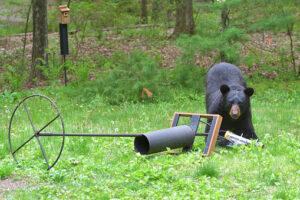
Bear Raiding Feeders
Well, the bear did it again. It tore up some of the spindles on the porch railing, tipped over a couple of the vegetable pots, and yanked a six-foot portion of our picket fence off the posts. All this to remind me that I should not feed the birds this time of year. It’s May.
So what to do but put away all the feeders? Maybe I can try again in the fall when bears retreat to the dens for their winter snooze.
This pretty much gave me great moments of sadness especially since I’ve had to shed other favorite activities.
Bird Antics Bring Joy
But today was a day of great surprises. My beautiful main stays, the birds, were everywhere. As I sat in the kitchen peering out the window, I spotted the adult turkeys poking their heads above the uncut hay. I could feel their parental thoughts “The coast is clear so keep scrambling forward.” The chicks were not seen but definitely there. A goldfinch zipped over them. Then I saw two wood thrashers near the holly tree scavenging for insects. Oh, my look how that crow struts!
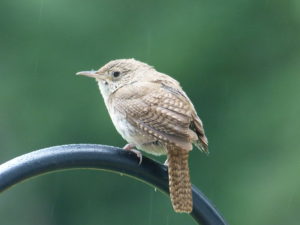
Wrens are Chatterers
Listen, that’s the wren by the back door. She keeps chattering to remind me she built her condo in the hanging planter. Then a flash of bright red caught my eye as I walked onto the porch. It’s a cardinal. Then the female house finch flicked from her nest over the front door light. She doesn’t like me stepping onto the porch. She is quite timid.
Even though the feeders have been down for nearly two months, the birds have kept their vigil at my country home much to my delight. They are in the trees, along the lane, and in the hayfield. What a great day!
by Winding Pathways | Sep 8, 2022 | (Sub)Urban Homesteading, Birds, Nature
Sometimes an animal’s name is misleading. Take the common nighthawks. It’s not a hawk and it doesn’t only fly at night. We often sit evenings on our back deck at Winding Pathways. In late summer 2022, we have been treated as dozens of aerial dancers – nighthawks – wheel overhead stalking mosquitoes and other insects. They can have all they can catch!
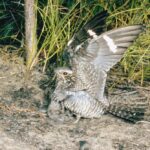
Common Nighthawks blend in with the ground. courtesy Free Photos
These birds are wonders. Closely related to whip-poor-wills, the brown feathers of the common nighthawk render them nearly invisible when resting in dry leaves or gravel during the day. They love evenings and wing overhead with their massive mouths open to snare tasty insects from the air.
Sometimes they pass just a few feet overhead. Occasionally they’re so high up that they are just fast-moving-turning-on-a-dime specks. Always they show distinct white stripes on the underside of their pointed wings.
Habits of Nighthawks
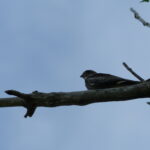
Resting nighthawk
We watched dozens of them in September 2022 and know that like many other migratory birds, they’ll join other birds for winter quarters in South America, so we enjoy them when we can. Daily we track bird migrations on the birdcast.info site. Nighthawks are one of the most widespread of North American birds, visible over farms, forests, and cities. Sometimes they even nest on gravel surfaced roofs of commercial buildings downtown and gravel areas of yards. We’ve caught glimpses of them resting on tree limbs. Watch the video to see many characteristics of nighthawks – their flight, sounds (listen for the “boom” of their wings), resting habits like sinking into the ground and yawning, and toward the end of this mini-documentary -the “waddle.” Fun!
Unfortunately, nighthawks have been declining about 1% a year since the 1960s. Why??? Pesticides, perhaps, reduce the insects that nighthawks feed on, and the loss of habitat. We don’t know for sure, but we enjoy watching their evening sky dance and hope people help them reverse their decline to continue their sky dance over much of the continent gobbling up insects.
by Winding Pathways | Sep 1, 2022 | Nature, Reflections/Profiles
Remembering Sockeye Work
Rich Patterson and Kammi Matson of the Popsie Fish Company
In early July we enjoyed an amazing natural phenomenon at the Campbell Creek Science Center in Anchorage, AK. We walked with our daughter to the small stream that gives the Center its name and spotted splotches of red in quieter stretches of the Creek.
Sockeye Salmon were resting there after wriggling up rushing riffles and rapids. Seeing the fish brought back Rich’s 50-year memory of the scientific work he did on this fish species a half-century before.
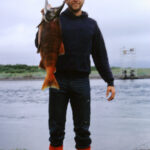
Red salmon spawning color and kype.
In 1972 he was stationed at the Ugashik Tower on a remote river about 250 miles southwest of Anchorage. The task of his crew was to count Red Salmon migrating upstream and to report numbers to the head biologist in the town of King Salmon. Counting was done by perching in a riverbank tower made of aluminum scaffolding, peering into the water, and counting fish swimming by.
At first, work was boring. No salmon were in the river. Then a miraculous change happened. Rich glanced downstream to view a river of red plowing upstream against the strong current. For two weeks, night and day, salmon passed the tower on their way upstream.
Salmon Species
Five species of salmon are native to North America while a sixth only lives in Asia. All are anadromous, meaning that they hatch in freshwater but spend much of their life in the sea before returning to their natal stream to spawn. While other Pacific salmon like the King, Chum, Silver, and Pink, feed on chunky animals, mostly small fish, Sockeyes, or Reds as they are called in Alaska, prefer different food.
What is Unique About Sockeye?
Most Sockeyes spawn in the gravel of small tributary streams that feed Alaska’s vast lakes of Iliamna, Becherof, Naknek, Ugashik, and others. Tiny fish descend the stream and usually spend two years swimming around the lake straining plankton from the water until they reach roughly sardine size. Then, on a few April nights, millions of salmon, called smolts, descend the big rivers to Bristol Bay. For the next two years, they circle the vast Pacific once or twice, eating zooplankton, small fish, and squid. They swim with their mouths open so their filter-like gills can strain tiny animals from the water.
When a smolt enters the Bay at two years old it weighs under an ounce. Think of that! When it returns from the nutrient-rich ocean two years later it weighs between six and 12 pounds!
For most of their lives, Red Salmon are not red. They’re silvery. When entering freshwater their skin quickly turns bright red and their heads green. Males grow a formidable-looking hooked snout. On their journey, they cross a lake and mate in small feeder streams beyond.
Sockeye are probably the most delicious of all fish, eagerly caught by commercial fishers based in Bristol Bay to be canned, flash frozen, or shipped fresh to consumers around the world. The best-tasting fish are caught before their skin reddens, but their rich flesh is always bright red.
How Do We Avoid Overfishing?
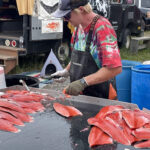
Processing salmon
Most people realize that overfishing devastated the once vast schools of Atlantic Cod off New England and Canada. So, how can science work with commercial and sport fishers to ensure that Alaska’s red salmon remain abundant while providing a generous harvest of delicious food?
In theory, it’s simple. Let enough fish “escape” nets and hooks to spawn a new generation and add the fertility of their dead bodies into the water to nourish the plankton that feed youthful salmon. In practice, it’s more complex.
Biologists rely on electronics and human eyes to make sure enough salmon ascend rivers to keep numbers high and sustainable. Fishers are allowed to catch the surplus. It works. Vast numbers of Red Salmon, perhaps as many as 50 million, were caught and shipped in 2022 while plenty of escapees spawned. Anyone can enjoy eating a salmon filet knowing it’s not sending Red Salmon the way of the Atlantic Cod.
How Can You Get the BEST Sockeye in Iowa?
We love eating Sockeye Salmon and prefer grilling it over a gentle wood fire. The trouble is we live in Iowa. No salmon here, but a few years ago we were able to buy Egegik River fish from a local meat market that has since gone out of business. We now order from the Popsie Fish Company, which sends ten pounds of frozen filets to our home.
Popsie caught these fish near Alaska’s second largest lake, Becharof. That’s close to where Rich worked years ago at Ugashik. The Egegik River flows from Lake Becharof to Bristol Bay.
To order fish go to Popsie’s website. To see Sockeye in their red-colored glory without the need to fly to the distant Alaska Peninsula visit the Campbell Creek Science Center in mid-July in Anchorage and walk along a pleasant trail to the Creek. Its salmon run is modest in size but easily accessed.
by Winding Pathways | Aug 25, 2022 | (Sub)Urban Homesteading, Birds, Nature
While We Were Sleeping
We were tired on the evening of August 21. Crawling into bed at 9 pm we were oblivious to the traffic jam winging over our insulated roof. Late August. The fall bird migration has started. That night it picked up steam.
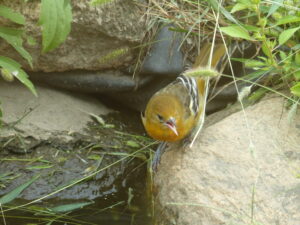
Birds stop for a drink and to fill up on the berries nearby.
In the morning we checked the BirdCast Migration Database and were astounded to learn that 883,000 birds crossed Linn County, Iowa, where we live, the evening before. Heading south, large numbers of birds began streaming overhead shortly after we turned off our reading lights. Migration usually starts just after sunset and peaks in the first couple of hours of darkness, but last night birds streamed over most of the night going south at an average speed of 26 miles an hour at an altitude of up to 2400 feet.
Technology Merged with Observation
How do we know? Well, we didn’t sit on the roof with night vision optics. We merely logged into the Cornell Laboratory of Ornithology’s Migration Dashboard at birdcast.info.
The technology is almost as fascinating as the information it reveals. The Live Migration videos show the action through the night. Fascinating!
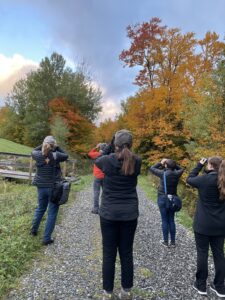
Pause to listen and look. Binoculars help.
The Lab collects data from 143 radar installations scattered across the country. This provides a clear picture of the number of birds migrating at any given time, their direction and speed, and how high they are flying. Radar can’t determine species, but years of data collected by ground observation and compiled by the Lab through eBird helps give an accurate picture of the likely species on the move. The list shows that probably 14 species went overhead while we slept.
Until a few years ago we were casual birders. The amazing science and sharing the Lab of Ornithology provides fascinate us and has sensitized us to the marvel and beauty of birds, their amazing navigation ability, their adaptations, and, unfortunately, the threats they face.
Apps Enhance Birding Experience
We have the Lab’s Merlin and Bird apps on our phone. The first is a pocket-sized field guide packed with more information than old paper field guides ever were able to provide. It helps us identify an unknown species, see its range, and even hear its calls and songs. A new feature helps identify birds by their song. Click it on and hold the phone toward where the call is coming from, and it identifies the species, usually correctly.
eBird enables us to easily compile a list of birds sighted on a particular day and forward our data to the Lab. Thousands of birders worldwide send their data, giving the Lab invaluable information on where birds are and how they move……as well as population trends.
Technology and Birds! What’s Not to Love?
Love technology? Love birds? These wonderful tools provided free from the Cornell University Laboratory of Ornithology merge the two. It’s a portal to many pages and other sites that include everything from nest webcams to detailed information about each species. Kudos to the Lab.
by Winding Pathways | Aug 11, 2022 | (Sub)Urban Homesteading, Bugs, Garden/Yard, Garden/Yard, Nature
Imagine how embarrassing it would be to be caught stark naked in public. Maybe that’s how the Walking Stick, a huge insect, felt that we spotted clinging to a shelf outside our house.
About 3000 species of Walking Sticks live worldwide. All love hiding. Their camouflage is almost perfect. No doubt the one we discovered would have been far more comfortable clinging nearly invisible on tree bark.
Although common and huge some species can be upwards of 20 inches long! They’re nearly impossible to spot as they lurk on twigs and bark. We likely walk right by many. They simply hide in plain sight. The name of their order is Phasmatodea, meaning apparition. It perfectly describes them.
The one we spotted must have been lost. Rather than comfortably blending into the woods our gangly stick-looking insect contrasted against our shelf as naked as a jaybird. We couldn’t miss spotting it.
Herbivorous Walking Sticks spend nights munching on leaves and rest during daylight. Females are usually bigger than males and usually just drop their eggs to the ground. Growth is slow, and the babies can take three to 12 months to mature. That’s glacial growth for an insect, but they can live for two years if not devoured by birds, small mammals, or predatory insects. Insecticides devastate them.
Walking Sticks don’t bite or sting and are one of the thousands of nature’s wonders to discover in an ecologically healthy yard. They’re downright fascinating and fun to share with children.
-
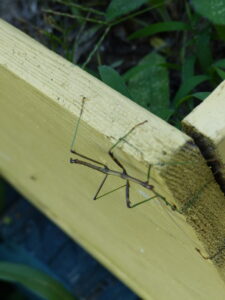
-
Easy to see
-
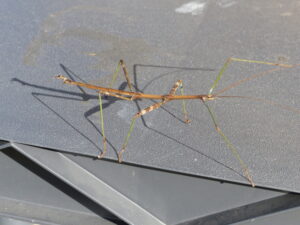
-
A large herbivore.
-
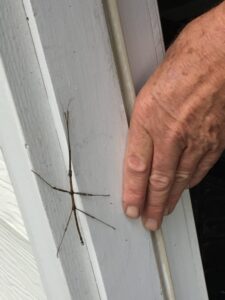
-
Walking Sticks are easy to spot on plain backgrounds.













